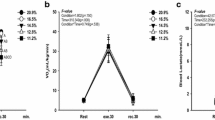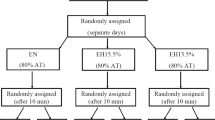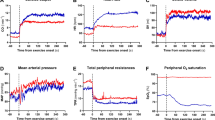Summary
Ventilatory and circulatory drives elicited by exercise-simulating perfusion of the circulatory isolated hindleg were examined in 10 trained (TR) and untrained (UTR) rats. TR were submitted to endurance training on a motordriven treadmill (30·min−1 at a grade of 10%, 5 days a week for 30 min). Exercise was simulated by perfusion with modified tyrode solutions:I.) hypoxic, enriched with lactic acid (15 mmol·l−1), II.) normoxic, enriched with lactic acid. III.) hypoxic without lactic acid. Perfusion was performed in anaesthetized animals through cannulae in the femoral artery and vein; the hindled was connected to the rest of the body only by nerve and bone. 10 min of control perfusion (normoxic tyrode solution) was followed by a 20 min test period and another 10 min control perfusion. Apart from heart rate (HR), respiratory rate (RR) and several outflow parameters were measured ([K+], [Na+], [lactate], pH, PO2, PCO2). During control periods HR was slightly higher in UTR than in TR (375.5±3.9 (SE) vs. 364.1±5.5 beats/min−1,p<0.6 n.s.), and RR in UTR was significantly higher than those in TR (61.5±0.4 bpm vs. 55.5±3.9 breaths·min−1,p<0.001). During the test periods both HR and RR in UTR increased significantly while in TR they did not (e.g. in series I mean HR and RR in UTR increased by 8.9±1.2 beats·min−1 and 1.4±0.1 breaths·min−1 respectively, whereas in TR the changes were-2.9±1.5 beats·min−1 and -0.8±0.2 breaths·min−1. A significant difference between UTR and TR can only partly be due to diminished venous [H+] caused by better H+ buffering in TR. Particularly in the tests with lactic acid, lactate was far above threshold level. It can be concluded that the metabolic stimulus and the afferent branch of the cardiorespiratory reflex have been attenuated by endurance training.
Similar content being viewed by others
References
Alam M, Smirk FH (1938) Observation in man on a pulseaccelerating reflex from the voluntary muscles of the legs. J Physiol 92:167–177
Carcassi AM, Concu A, Decandia M, Onnis M, Orani GP, Piras MB (1983) Respiratory responses to stimulation of large fibers afferent from muscle receptors in cats. Pflügers Arch 399:309–314
Clausen JP (1977) Effect of physical training on cardiovascular adjustment to exercise in man. Physiol Rev 57:779–815
Cox RH, Hubbard JW, Lawler JE, Sanders BJ, Mitchell VP (1985) Cardiovascular and sympathoadrenal responses to stress in swim-trained rats. J Appl Physiol 58:1207–1214
Davies KJA, Packer L, Brooks G (1981) Biochemical adaptation of mitochondria, muscle and whole-animal respiration to endurance training. Arch Biochem and Biophys 209:539–554
Dempsey JA, Hanson P, Henderson K (1984) Exercise-induced alveolar hypoxemia in healthy human subjects at sea-level. J Physiol (Lond) 355:161–175
Dempsey JA, Fregosi RF (1985) Adaptability of the pulmonary system to changing metabolic requirements. Am J Cardiol 55:59D-67D
Häkkinen K, Komi PV (1983) Changes in neuromuscular performance in voluntary and reflex contraction during strength training in man. Int J Sports Med 4:282–288
Häkkinen K, Komi PV (1986) Training-induced changes in neuromuscular performance under voluntary and reflex conditions. Eur J Appl Physiol 55:147–155
Hohorst HJ (1970) L(+)-Lactat. Bestimmung mit Lactat-Dehydrogenase und NAD. In:Bergmeyer HU (ed) Methoden der enzymatischen Analyse, Vol. II. Verlag Chemie, Weinheim, pp 1425–1329
Kao FF (1963) An experimental study of the pathways involved in exercise hyperpnoea employing cross-circulation techniques. In:Cunningham DJC, Lloyd BB (eds). Blackwell, Oxford, pp 461–502
Kumazawa T, Mizumura K (1977) Thin-fibre receptors responding to mechanical, chemical, and thermal stimulation in the skeletal muscle of the dog. J Physiol 273:179–194
Lehmann M, Keul J, Huber G, Da Prada M (1981) Plasma catecholamines in trained and untrained volunteers during graduated exercise. Int J Sports Med 2:143–147
Mader A, Heck H (1986) A theory of the metabolic origin of “aerobic threshold”. Int J Sports Med 7:45–65
McCloskey DJ, Mitchell JH (1972) Reflex cardio-vascular and respiratory responses originating in exercising muscle. J Physiol (Lond) 224:173–186
Müller EA (1943) Die Pulszahl als Kennzeichen für Stoffaustausch und Ermüdbarkeit des arbeitenden Muskels. Arbeitsphysiologie 12:92–104
Neary PJ, MacDongall JD, Bachus R, Wenger HA (1985) The relationship between lactate and ventilatory thresholds:coincidental or cause and effect? Eur J Appl Physiol 54:104–108
Rybicki KJ, Kaufman MP, Kenyon JL, Mitchell JH (1984) Arterial pressure responses to increasing interstitial potassium in hindlimb muscle of dogs. Am J Physiol 247:R717–721
Saltin B, Henrikson J (1984) Buffer capacity and lactate accumulation in skeletal muscle of trained and untrained men. Acta Physiol Scand 122:131–139
Saltin B, Nazar K, Costil DL, Stein E, Jannsson E, Essen B, Gollnick PD (1976) The nature of the training response; peripheral and central adaptions to one-legged exercise. Acta Physiol Scand 96:289–305
Stegemann J, Busert A, Brock D (1974) Influence of fitness on the blood pressure control system in man. Aerospace Med 45:45–48
Stainsby WN, Otis AB (1964) Blood flow, blood oxygen tension, oxygen uptake, and oxygen transport in skeletal muscle. Am J Physiol 206:858–866
Stegemann J, Seez P, Kremer W, Böning D (1975) A mathematical model of the ventilatory control systems to carbon dioxide with special reference to athletes and non-athletes. Pflügers Arch 356:223–236
Stegemann J, Ulner HV, Böning D (1967) Auslösung peripherer neurogener Atmungs- und Kreislaufantriebe durch Erhöhung des CO2-Druckes in größeren Muskelgruppen. Pflügers Arch 293:155–164
Thimm F, Baum K (1987) Response of chemosensitive nerve fibers of group III and IV to metabolic changes in rat muscles. Pflügers Arch
Thimm F, Tibes U (1978) Effect of K+, osmolality, lactic acid, orthophosphate and epinephrine on muscular receptors with group I, III and IV afferents. J Physiol (Lond) 284:182–183P
Thimm F, Carvalho M, Babka M, Meier zu Verl E (1984) Reflex increases in heart-rate induced by perfusing the hindleg of the rat with solutions containing lactic acid. Pflügers Arch 400:286–293
Thimm F, Dienstel E, Meier zu Verl E (1986) Heart rate changes caused by varying the oxygen supply to isolated hindlegs of rats. Eur J Appl Physiol 55:273–280
Tibes U (1977) Reflex inputs to the cardiovascular and respiratory centers from dynamically working canine muscles. Circ Res 41:332–341
Wildenthal K, Mierzwiak DS, Skinner NS, Mitchell JH (1968) Potassium-induced cardiovascular and ventilatory reflexes from the dog hindlimb. Am J Physiol 215:542–548
Author information
Authors and Affiliations
Additional information
Dedicated to J. Stegemann on the occasion of his 60th anniversary
Rights and permissions
About this article
Cite this article
Thimm, F., Gerber, B. Respiratory and cardiac responses to exercise — simulating peripheral perfusion in endurance trained and untrained rats. Europ. J. Appl. Physiol. 58, 105–111 (1988). https://doi.org/10.1007/BF00636612
Accepted:
Issue Date:
DOI: https://doi.org/10.1007/BF00636612




